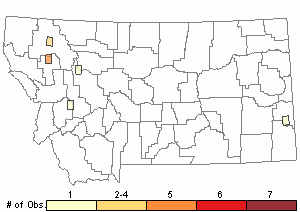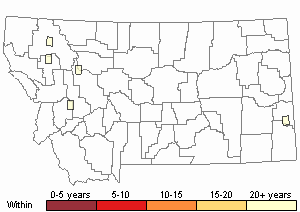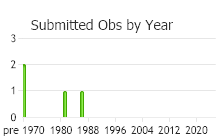View in other NatureServe Network Field Guides
NatureServe
Montana
Utah
Wyoming
Idaho
Wisconsin
British Columbia
South Carolina
Yukon
California
New York
Snaky Fern Moss - Hypnum pallescens
Other Names:
Hypnum reptile
General Description
Plants: Pleurocarpous, typically growing in interwoven mats (Lawton 1971), yellow to green with yellow or brown tones, or deep green (FNA 2014), somewhat glossy (Crum and Anderson et al. 1981). Stems typically prostrate, pinnate, sometimes erratically so, 2-5 cm, green with yellow tones to more yellow; branches growing in a level plane, usually 2-6 mm in length; hyalodermis lacking and central strand faint; pseudoparaphyllia lance-shaped, sparse (FNA 2014); cortical stem cells tiny and with thick walls (Lawton 1971).
Stem Leaves: Densely spaced, the bases lightly upright and the tips (Crum and Anderson et al. 1981) curved in sickle-like fashion and turned in one direction, seldom straight, 0.6-1.1 mm in length, to 0.6 mm in width (FNA 2014), cupped (Lawton 1971), egg-shaped to lance-shaped with oblong tendencies (FNA 2014), slowly to suddenly narrowing (Crum and Anderson et al. 1981) to a short acumen, the acumen narrow to somewhat broad, the base not extending down the stem or only faintly so, not lobed; leaf edges usually curved back and downward below, occasionally to the leaf tip, and either widely or narrowly so, nearly smooth to faintly and finely saw-toothed below, saw-toothed above; costa almost always paired, faint to quite evident (FNA 2014).
Branch Leaves: Edges often more conspicuously saw-toothed and the apex tapering more slowly than in the stem leaves (FNA 2014).
Leaf Cells: Laminal cells with faint papillae at both ends (FNA 2014); upper laminal cells long and narrowly diamond-shaped to linear with thickish walls (Crum and Anderson et al. 1981); medial laminal cells narrower than the basal cells, nonporose (FNA 2014) or barely porose (Lawton 1971); basal laminal cells frequently colored yellow and with porose walls; alar cells square to oblong with the longer side crosswise, not transparent, extending 8-15 or more cells up the margin, the region not concave nor clearly delineated (FNA 2014).
Phenology
Fruit ripens late spring to summer (FNA 2014).
Diagnostic Characteristics
Plants of Hypnum pallescens are well-anchored to substrates by rhizoids (FNA 2014).
The similar Hypnum recurvatum has more abundant alar cells, and its leaf tips are hooked to coiled nearly into a circle rather than curved like a sickle as in Hypnum pallescens (FNA 2014).
Range Comments
North American Range
AK to NT, BC to NL and NS, AZ, MT to NM, SD, MN to MO, WI to AL and east from that line to the coastal states except for FL (FNA 2014). Known in Montana from Carter, Flathead, Granite, and Lake Counties (Elliott and Pipp 2016).
Observations in Montana Natural Heritage Program Database
Number of Observations: 12
(Click on the following maps and charts to see full sized version)
Map Help and Descriptions
Relative Density

Recency


 (Observations spanning multiple months or years are excluded from time charts)
(Observations spanning multiple months or years are excluded from time charts)
Habitat
Rock (usually acidic), humus, and rotting wood (Elliott and Pipp 2016), growing on trees, particularly at the bottom, wooded habitats (FNA 2014), dry or damp (Crum and Anderson et al. 1981). Occurring from lowlands to about 6560 feet elevation (FNA 2014).
Reproductive Characteristics
Autoicous, sporophytes typically numerous in summer (FNA 2014). Perigonia and perichaetia borne on the stems (Lawton 1971), exterior perichaetial bracts bent back and downward; interior perichaetial bracts upright with a thin acumen, and margins saw-toothed above. Seta 7-15 mm tall, somewhat ochre to red, smooth. Capsule 1-2.3 mm in length, somewhat yellow to deep brown, tilted to level, seldom nearly upright (FNA 2014), bowed, shrunken below the opening when dry (Lawton 1971); operculum cone-shaped (FNA 2014), the rostrum tilted (Lawton 1971); exostome teeth 16, with a zigzag line on the outer face, fine lines or ridges below, and papillae above; endostome processes 16, similar in height as the teeth, keeled, cilia present. Calyptra hairless and draping hood-like (FNA 2014).
Stewardship Responsibility
References
- Literature Cited AboveLegend:
 View Online Publication
View Online Publication Crum, H.A. and L.E. Anderson. 1981. Mosses of Eastern North America. 2 volumes. Columbia University Press, New York. 1328 pp.
Crum, H.A. and L.E. Anderson. 1981. Mosses of Eastern North America. 2 volumes. Columbia University Press, New York. 1328 pp. Elliott, J.C. and A.K. Pipp. 2018. A Checklist of Montana Mosses (1880-2018). Updated 3 January, 2020. Montana Natural Heritage Program, Helena, Montana. 73 pp.
Elliott, J.C. and A.K. Pipp. 2018. A Checklist of Montana Mosses (1880-2018). Updated 3 January, 2020. Montana Natural Heritage Program, Helena, Montana. 73 pp. Flora of North America Editorial Committee, eds. 2014. Flora of North America North of Mexico. Volume 28. Bryophytes: Mosses, Part 2. Oxford University Press, Inc., NY. xxi + 702 pp.
Flora of North America Editorial Committee, eds. 2014. Flora of North America North of Mexico. Volume 28. Bryophytes: Mosses, Part 2. Oxford University Press, Inc., NY. xxi + 702 pp. Lawton, E. 1971. Moss Flora of the Pacific Northwest. Hattori Botanical Laboratory. Japan: Yamabuki-cho, Shinjuku-ku, Tokyo. 362 pages plus appendices.
Lawton, E. 1971. Moss Flora of the Pacific Northwest. Hattori Botanical Laboratory. Japan: Yamabuki-cho, Shinjuku-ku, Tokyo. 362 pages plus appendices.
- Additional ReferencesLegend:
 View Online Publication
View Online Publication
Do you know of a citation we're missing? Elliot, J. C. 1993. Second checklist of Montana mosses. Unpublished report. U.S. Forest Service, Region 1. Missoula, MT. 45 pp.
Elliot, J. C. 1993. Second checklist of Montana mosses. Unpublished report. U.S. Forest Service, Region 1. Missoula, MT. 45 pp. Lawton, E. 1971. Keys for the Identification of the Mosses on the Pacific Northwest. Reprinted from 'Moss Flora of the Pacific Northwest'. Published as Supplement No. 2 of the Journal of the Hattori Botanical Laboratory. Nichinan, Miyazaki, Japan. 66 pp.
Lawton, E. 1971. Keys for the Identification of the Mosses on the Pacific Northwest. Reprinted from 'Moss Flora of the Pacific Northwest'. Published as Supplement No. 2 of the Journal of the Hattori Botanical Laboratory. Nichinan, Miyazaki, Japan. 66 pp.
- Web Search Engines for Articles on "Snaky Fern Moss"





